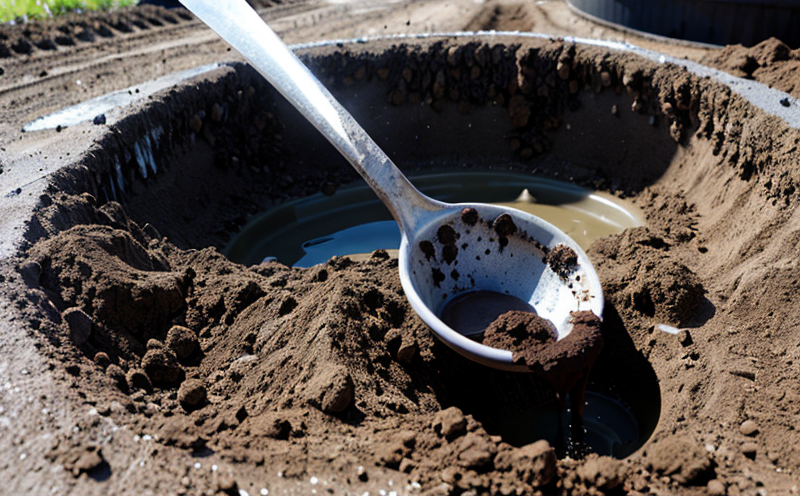ISO 5667-17 Sludge Sampling Guidance Test
The ISO 5667-17 standard provides comprehensive guidance on the sampling of sludges and biosolids, which are critical components in wastewater treatment processes. This service ensures that samples are collected accurately to represent the characteristics of the sludge or biosolids, thereby enabling reliable analysis and informed decision-making.
Accurate sampling is essential because it directly impacts the integrity of subsequent tests, such as those for organic matter content, nutrient levels, heavy metals, pathogens, and other relevant parameters. The standard covers various scenarios including aeration tanks, settling zones, dewatering units, and final disposal sites. It specifies detailed procedures to ensure that samples are representative of the bulk material from which they were taken.
The sampling process is divided into several stages: preparation, collection, storage, and transport. Each stage must be performed meticulously to avoid contamination or alteration of sample properties. Proper sampling helps in maintaining compliance with environmental regulations and ensures the quality of reclaimed biosolids for agricultural use.
Compliance with ISO 5667-17 is mandatory for facilities that generate sludges and biosolids, especially those operating under stringent environmental laws such as the U.S. Environmental Protection Agency (EPA) regulations or European Union directives like the Urban Waste Water Treatment Directive (91/271/EEC).
The standard emphasizes the importance of using appropriate sampling equipment and techniques to minimize sample bias. It recommends the use of multiple point sampling for large volumes, ensuring that every part of the sludge is represented in the final composite sample.
For facilities handling hazardous or toxic sludges, additional considerations are necessary to prevent worker exposure and environmental contamination. The ISO 5667-17 guidelines also provide recommendations for the safe handling and transport of such materials.
In summary, the ISO 5667-17 Sludge Sampling Guidance Test is a vital service that ensures accurate representation of sludge samples, supporting reliable analysis and regulatory compliance. Proper sampling techniques are crucial in maintaining environmental standards and ensuring the quality of biosolids for various applications.
Industry Applications
| Sector | Application |
|---|---|
| Water & Wastewater Treatment | - Ensuring compliance with environmental regulations and standards. |
| - Supporting the design and optimization of wastewater treatment processes. | |
| - Monitoring the performance of biological treatment systems. | |
| - Assessing the quality of biosolids for agricultural or land application. | |
| Environmental Management | - Evaluating the impact of sludge management practices on the environment. |
| - Providing data for risk assessment related to sludge and biosolid disposal. | |
| Agriculture | - Determining nutrient content in biosolids suitable for agricultural use. |
| - Ensuring the safety of biosolids used as fertilizer or soil amendment. |
Quality and Reliability Assurance
The ISO 5667-17 Sludge Sampling Guidance Test ensures that samples are collected accurately, representing the characteristics of sludges and biosolids. This accuracy is crucial for reliable analysis and informed decision-making in various sectors such as water & wastewater treatment, environmental management, and agriculture.
Quality assurance in this context involves several key aspects:
- Sample Preparation: Careful preparation ensures that the sample is not altered before collection. This includes controlling temperature, humidity, and other environmental factors that could affect sample properties.
- Sampling Techniques: Multiple point sampling is recommended for large volumes to ensure all parts of the sludge are represented in the final composite sample.
- Equipment Calibration: Using calibrated equipment ensures consistent and accurate measurements throughout the sampling process.
- Data Documentation: Comprehensive documentation of the sampling process, including location, time, and environmental conditions, supports traceability and reproducibility.
The reliability of the test results is further enhanced by adherence to international standards such as ISO 5667-17. These standards provide a consistent framework for sampling practices globally, ensuring that facilities in different regions can achieve comparable results.
Quality assurance also includes regular training and certification of personnel involved in the sampling process. This ensures that all staff are knowledgeable about best practices and the latest techniques recommended by the standard.
Competitive Advantage and Market Impact
- Regulatory Compliance: Facilities adhering to ISO 5667-17 gain a competitive edge by ensuring they meet stringent environmental regulations and standards.
- Informed Decision-Making: Accurate sampling leads to reliable data, enabling better decision-making processes in wastewater treatment operations.
- Risk Mitigation: By ensuring the quality of biosolids for agricultural or land application, facilities can mitigate risks associated with poor-quality materials.
- Enhanced Reputation: Compliance and accurate testing contribute to a positive reputation among stakeholders such as regulatory bodies, customers, and the public.
- Economic Benefits: Efficient sampling processes reduce costs related to retesting or non-compliance penalties.
The ISO 5667-17 Sludge Sampling Guidance Test is essential for facilities aiming to achieve these advantages. By ensuring accurate and reliable sample collection, this service supports sustainable practices that enhance operational efficiency and environmental stewardship.





